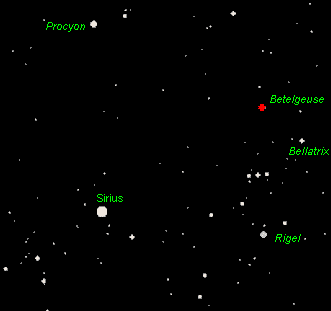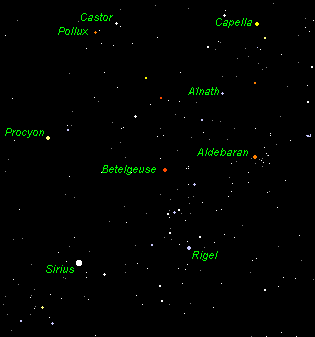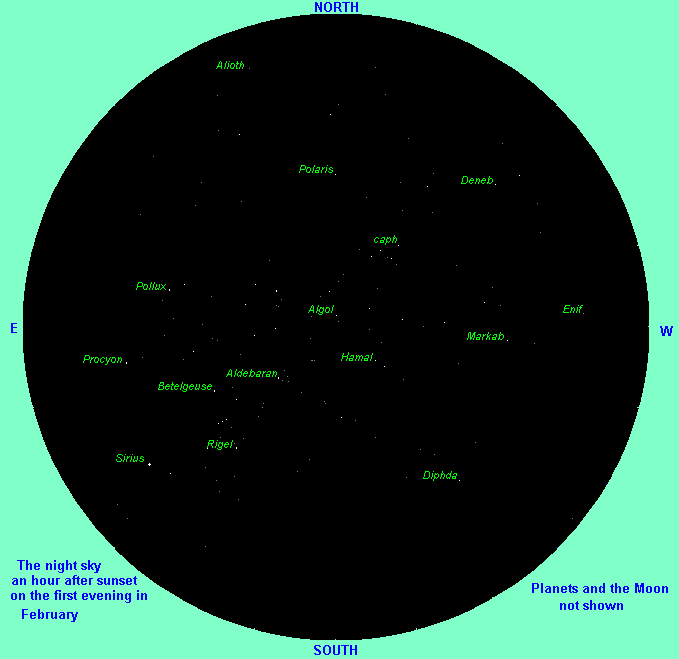February is a particularly difficult month for the amateur astronomer
because it's so cold outside!  However, those brave enough to tolerate
the weather will discover that February presents a beautiful night
sky. Granted, the western sky is kind of dull. Fomalhaut, the brightest star near the southwest horizon, sets about an hour after the Sun. Most of the Great Summer Triangle
has already set with the Sun but Deneb gives us a bit of
a show before also dipping below the horizon.
However, those brave enough to tolerate
the weather will discover that February presents a beautiful night
sky. Granted, the western sky is kind of dull. Fomalhaut, the brightest star near the southwest horizon, sets about an hour after the Sun. Most of the Great Summer Triangle
has already set with the Sun but Deneb gives us a bit of
a show before also dipping below the horizon.
However, there are many bright stars in the east and they will be visible until the wee hours of the morning. Speaking of brightness - a star's relative brightness is designated by its magnitude. The smaller the magnitude the brighter the star. (It's like golf. The best golfers have the lowest scores.) This backwards scoring even applies to negative numbers but a star has to be very bright to be awarded a negative magnitude. This is a great month to learn some star magnitudes. Let me teach you how to identify a few bright stars.
|
Sirius is the brightest star in our night sky, with its magnitude of -1.1. In point of fact, this star is 25 times brighter than our Sun but, because Sirius is so far away (8.6 light-years, or about 77 million, million kilometers), it appears much dimmer. Sirius is in the constellation of Canis Major, the Big Dog, and has the nickname of "The Dog Star".
Ahead (west) of Canis Major is the hourglass-shaped constellation of Orion the Hunter. The white star Rigel (magnitude 0.2) defines his left knee and reddish star Betelgeuse (with a magnitude around 0.6) is in his right shoulder. Betelgeuse is a red giant - an old star that has swelled up as its nuclear fusion moved from its hydrogen-depleted core to its hydrogen-rich shell. As it puffed up, the surface of the star cooled down and Betelgeuse now has a surface temperature of only 3,000oC. Contrast that with white-hot Rigel. Its surface temperature is a sizzling 13,000oC! Following Orion, and above Canis Major, is the constellation of the Little Dog, Canis Minor, with its brightest star Procyon (magnitude 0.4). |  |
Notice that the three stars in Orion's belt point southeast to Sirius. Also notice that a line extended from Bellatrix, the star in Orion's left shoulder, through Betelgeuse, leads you to Canis Minor and Procyon.
|
The Hunter and his Dogs seem to
be chasing the Bull, Taurus, which is just to the west of them.
The Bull's right eye contains the bright red-orange
star Aldebaran (magnitude of 1.1). Notice that the three stars in Orion's belt point northwest to Aldebaran. The Bull's face and horns form a distinctive "V" shaped pattern extending as far as Alnath (magnitude 1.65).
If you imagine a line from Orion through Alnath and extend it farther north, towards Polaris, you come to the beautiful yellowish star called Capella (magnitude 0.1). Although it's nearly the same color and temperature as our Sun, Capella is actually 90 times brighter but, of course, it's much farther away. This star is the brightest star in the constellation of Auriga, The Charioteer. East of Capella and north of Procyon is the constellation of Gemini. Its brightest star, Pollux, is slightly orange and has a magnitude of 1.1. Its "dim twin", Castor, is not as bright (magnitude 1.6) and very white. From each of these two stars you can find a series of stars that form lines leading towards Taurus and Orion. By the way, I haven't included the planets in these images. |  |
Of course, it helps to have a map to get you oriented so here is a reverse color image of the map that will be easier on your printer. I've included some lines to show you the constellations and the names of a few more stars.
|
Your sky map for the month of FebruaryHere's a map of the clear, night sky as seen from the center of the USA on the first evening of this month, an hour after sunset. Specifically, this is the view of a clear sky from a latitude of 37N. Star-gazers farther north, such as in Minneapolis, Chicago and most of Europe, will have more of the northern sky visible and the southern sky will be obscured by the horizon. Vice versa for those who are farther south. The stars will not change position relative to each other, however, throughout the month, the Moon and planets will wander, so they are not shown. Only objects of magnitude 4.0 and brighter are displayed. Here's a reverse color image of the map that will be easier on your printer. |  |
On the 17th of February 1600, Giordano Bruno was burned at the
stake in Campo dei Fior because his ideas about
the origin and structure of the universe conflicted with those
of the church. 
Clyde Tombaugh discovered Pluto on February 18th 1930. He was examining some telescopic photos (called "plates") he had taken weeks earlier using a 13 inch telescope at the Lowell Observatory.
Miranda, the largest moon of Uranus, was discovered by Gerard Kuiper on February 16th 1948.
On the 20th of February 1962, Lt Colonel John H Glenn Jr became the first American in orbit. (Alan Shepard's flight nine months earlier was suborbital but still in "space" so Shepard was the first American in space.) Glenn spent nearly 5 hours in space as he orbited the Earth three times in his Mercury-Atlas 6 capsule. (In 1998 Glenn returned to orbit via the space shuttle Discovery and, at the age of 77 years, became the oldest space traveler.)
The USSR placed Luna 9 on the surface of the Moon on February 3rd 1966, making it the first spacecraft from Earth to soft land on another world.
Jocelyn Bell discovered the first pulsar on the 24th of February 1968.
On the morning of February 1st, 2003, Air Force Colonel Rick Husband (Commander), Navy Commander Willie McCool (Pilot), Navy Captain Dave Brown (Mission Specialist 1), Doctor Laurel Clark (Mission Specialist 4), Doctor Kalpana Chawla (Mission Specialist 2), Air Force Lt Colonel Mike Anderson (Mission Specialist 3) and Israeli Air Force Colonel Ilan Ramon (Payload Specialist) died when their spacecraft, the shuttle Columbia, broke up during re-entry. Evidence indicated that during lift-off two weeks earlier a piece of "foam", insulating the external fuel tank, broke off and damaged the port wing. This damage lead to structural failure during their re-entry.
I hope you found the Night Sky this Month to be helpful and educational. I invite you to return here monthly for new information.